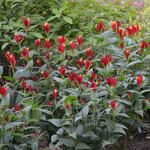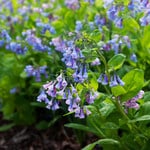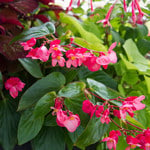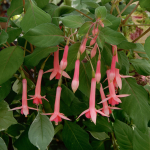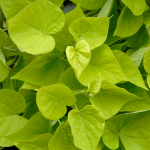Product Details
Polemonium reptans 'Stairway to Heaven' produces low mounds of green-and-white variegated foliage that provide a lively background for sprays of bell-shaped blue flowers that add color to sunny and part-sun gardens in spring and early summer. The creamy white leaf margins of this Jacob’s Ladder are often accented with pink in spring and when temperatures are cool. Plants prosper in evenly moist, woodsy soil and along the banks of streams. PP 15,187
The genus Polemonium includes at least 25 species. Members are native to temperate and arctic regions predominantly in the Northern Hemisphere and particularly to mountainous areas. Their common name, Jacob’s Ladder, recalls the Old Testament story of Jacob who dreamt about a ladder reaching to the heavens, a reference to the perennial’s pinnately compound leaves, which are ladderlike in the arrangement of their leaflets. Flowers are generally shades of blue (but can very occasionally be white, pink, or purple) and they bloom mostly in spring. The foliage remains handsome throughout summer. More upright forms of Jacob’s Ladder look lovely in perennial borders and woodland gardens, while the spreading varieties are ideal for adding to rock gardens and alpine collections.
For more information on growing and care, click Growing Guide.
Shipping
HOW PLANTS ARE SHIPPED
The size of the plants we ship has been selected to reduce the shock of transplanting. For some, this means a large, bareroot crown. Others cannot travel bareroot or transplant best if grown in containers. We ship these perennials and annuals in 1 pint pots, except as noted. We must point out that many perennials will not bloom the first year after planting, but will the following year, amply rewarding your patience. We ship bulbs as dormant, bare bulbs, sometimes with some wood shavings or moss. Shrubs, Roses, vines, and other woody plants may be shipped bareroot or in pots. The size of the pot is noted in the quick facts for each item.
WHEN WE SHIP
We ship our bulbs and plants at the right time for planting in your area, except as noted, with orders dispatched on a first-come, first-served basis by climate zone. We also ship a wide range of containers and planters, tools, supplies, fertilizers, garden wear, garden decor items, as well as indoor decorations like wreaths and dried bouquets when available. Estimated dates for shipping are indicated in the green Shipping Details box for each item. Please supply a street address for delivery. Kindly contact us with two weeks notice, if you'll be away at the expected time of delivery.
OUR GUARANTEE
We guarantee to ship plants that are in prime condition for growing. If your order is damaged or fails to meet your expectations, we will cheerfully replace or refund it. Please contact our Customer Service Department at 1-800-503-9624 or email us at [email protected]. Please include your order number or customer number when contacting us.
Reviews
There are no reviews yet. Be first to Write a Review.
Growing guide
Latin Name Pronunciation: poh-leh-moh' nee-um
This U.S. native perennial wildflower prospers in evenly moist, woodsy soil and along the banks of streams. Foliage appears in spring then in May and June, loose stalks of bell-shaped flowers make their appearance, generally in shades of blue. Although plants have rhizomes and form clumps of about 15-18" across, they spread by self-seeding when in the right growing conditions. More upright forms of Jacob’s Ladder look lovely in perennial borders and woodland gardens, while the spreading varieties are ideal for adding to rock gardens and alpine collections.
- Light: Prefers part shade but will tolerate full sun in cool summer climates.
- Watering: Grow in moist, humusy, well-drained soil that is rich in organic matter. Does not like to be soggy. Once well-established it is drought tolerant.
- Fertilizer, Soil & pH: Fertilize lightly once in early spring with 5-10-5 or 10-10-10.
- Pests/Diseases: No serious insect or disease problems if planted in well-drained soil and not overwatered. Deer resistant.
- Reflowering: Cut back flower stems to the base after flowering to encourage rebloom.
- Dividing/Transplanting: Space plants 12-15” apart. Grows by rhizomes but spreads by self-seeding. Can be divided in early spring as new growth appears. Long flower stems may become leggy in the spring and can be trimmed.
- Companions: Combine with Hostas, Ferns, Heucheras
Calendar of Care
- Early Spring: Cut back any remaining stems from the fall. After the plants in your garden have emerged, weed around them and apply a light 1-2” layer of compost.
- Late Spring: Once the ground warms, a light 2-3” layer of mulch will help conserve moisture in the soil and insulate roots. After flowering, cut back flower stalks to the base to encourage reblooming and to tidy leggy plants. Flowers can also be removed to prevent self-seeding.
- Summer: Be sure plants are getting enough water. If weather conditions are dry, monitor the soil for moisture and, if necessary, get out the hose or watering can. Keep in mind that plants in their first season need roughly 1” of water per week. Weed to remove unwanted plants that can crowd or take nutrients away from your plants.
- Fall & End-of-Season Care: Plants can be cut back to the ground once they finish blooming or you may choose to leave them standing until early spring.

